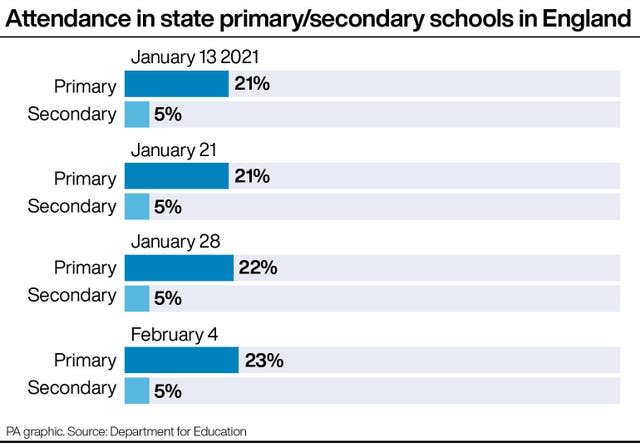Number of pupils attending school in past week rises as demand grows
The proportion of pupils in England being taught on-site has risen in a week with nearly one in four primary school children in class, Government data shows.
Overall 16% of state school pupils were in class on February 4, up from 15% the week before, according to figures from the Department for Education (DfE).
Nearly a quarter (23%) of primary school pupils were on-site last week, which is a rise on the week before (22%), while 5% of secondary school students were in class – the same as on January 28.
Pupils in schools and colleges in England – except children of key workers and vulnerable pupils – have been told to learn remotely during the lockdown.
Mr Johnson has said he hopes it will be safe to begin the reopening of England’s schools from March 8.

Approximately 895,000 children of key workers were in attendance last week, up from 850,000 on January 28.
This represents 70% of all pupils in attendance at school last week.
The latest figures also show that an additional 59,160 laptops and tablets have been delivered or dispatched by the Government to help with remote learning in the past week.
New figures from the DfE suggest that 424,428 devices have been sent to councils, academy trusts, schools and colleges across England since the lockdown began on January 4 – which is an additional 59,160 devices compared to the same time last week.
It means 986,849 laptops and tablets have been delivered or dispatched to support pupils with remote education since the start of the scheme.
Geoff Barton, general secretary of the Association of School and College Leaders (ASCL), said he was not convinced that the Government fully understood the level of need for devices among families.
He added that the attendance figures indicated that “demand is continuing to rise for school places.”
Mr Barton said: “We have asked the Department for Education whether the number of children in school at any one time needs to be capped in light of the fact that the Prime Minister has urged people to stay at home and save lives.
“However the department appears to be unconcerned and has told us that it currently has no plans to further reduce attendance.
“We agree that it is important to have provision for vulnerable children and children of key workers. But we are not sure how there being no upper limit on this provision squares with the notion of a national lockdown.”
James Bowen, director of policy for school leaders’ union NAHT, said: “While it is good to see more devices being delivered to pupils that need them, the Government has still failed to answer why it has excluded younger pupils from the scheme.
“We know that younger primary pupils are using technology to access remote learning too so why are the Government ignoring these children when it comes to providing them with the technology they need?”
A DfE spokeswoman said: “We continue to provide laptops and tablets at huge speed and scale for those children who need them the most.
“Almost one million have now been delivered to schools and councils from the 1.3 million being provided, with just under 425,000 delivered since the beginning of January, when schools closed to most pupils.
“This is helping ensure children can continue to receive the best possible education while at home.
“Schools remain open to vulnerable children and children of critical workers, but if critical workers can work from home and look after their children at the same time then they should do so.”


